Spider-Man 2 (2004) vs Disney Spider-Man
Disney’s corporate Spider-Man can’t match the materialist aesthetics of Spider-Man 2
A new Spider-Man movie is coming out this week, Spider-Man: No Way Home, and it will probably make a ton of money—this feels like the first big movie that people will actually get out to the theaters in big numbers to see, post-Covid. I’m sure it will be alright, as all the Disney Marvel movies are, and maybe even slightly better than alright, as the two earlier films in the Disney Marvel Spider-Man trilogy have been (2017’s Spider-Man: Homecoming and 2019’s Spider-Man: Far From Home). But sadly, the time has passed when Spider-Man movies, or really any big movies, could have imagination and aesthetic value in any significant way.
But this was not always the case. It’s a good time to look back on the best Spider-Man movie ever made: Sam Raimi’s Spider-Man 2 (2004), with Tobey Maguire as Peter Parker. Not only is it the best Spider-Man movie ever, it’s arguably the best superhero movie ever made (with the possible exception of The Dark Knight (2008)). And it’s one of the best sequels ever (up there with The Godfather Part 2, Terminator 2: Judgment Day, and Dark Knight, and a few select others). The new Spider-Man movie coming out this week is the culmination of a trilogy of films that started with 2017’s Spider-Man: Homecoming. That movie was I believe the second time we saw the new Spider-Man played by weird little British guy Tom Holland (he had appeared in Captain America: Civil War (aka Captain America 3) before he got his own movie). Then he was in at least two Avengers movies I think. But even though this is his like 6th time (?) as Spidey, he still doesn’t feel all that familiar to me—he’s played Spider-Man in more movies than anyone, but I still feel like Tobey Maguire is Spider-Man.
In this new Disney Marvel trilogy, the word “home” is in the title of each of them, which feels kind of manipulative, like they’re trying to get us to feel a false, cheap sense of familiarity and rootedness in this Disney Spider-Man continuity. You’re Home! You’re always Home with Disney! It’s exploitative—we aren’t home, this Spider-Man is not familiar really. He’s been mostly part of an ensemble, and thrown into wild places all the time—other planets fighting Thanos in the Infinity War, Europe in the last one. And there’s really no sense of place in the new movies, and that is a big mistake for Spider-Man, because his place, New York City, is so much a part of who he is as a character. His powers wouldn’t even really work anywhere else in the same way—he needs tons of tall buildings close together to climb on and swing from. Batman can be Batman anywhere basically, same with Superman—but Spidey is only really fully Spidey in Manhattan. (While we’re talking about Batman and Superman, Spider-Man is the most dialectical superhero on a visual level because his costume kind of combines the best things about Batman and Superman. It’s bright and colorful like Superman—he isn’t trying to hide or move in shadows like Batman, whose costume is all about stealth. But he’s also not fully exposed like Superman is; he wears a mask, like Batman. So he’s very much bright, colorful, open, in plain sight, like Superman—but still hidden, mysterious, like Batman. Best of both worlds).
In this new trilogy, Tom Holland’s Spidey spends some time in New York in the first movie, which is mostly about his high school experience—but it is mainly about Tony Stark/Iron Man, who casts his shadow over the whole thing, and Spidey feels like a supporting character in his own movie. So you don’t get that firm a sense of place, even in that first movie that is meant to establish this new Spidey. And in the next two movies in the Homecoming trilogy he goes all around the world (the plot of Far From Home is that he goes on a school field trip to Europe) and in this new one he is going into different universes (or having different universes come into this universe).
So the most crucial thing about Spider-Man is lost—his connection to a place, and not just any place, but New York City, a real life place. It’s often said that Spider-Man is the most relatable superhero, because he is just some nerdy kid and he lives paycheck to paycheck—but he’s also relatable because he lives in a real place, New York, in a way that separates him from Superman and Batman, who live in the fake cities of Metropolis and Gotham, respectively. And this is one of the main things that Spider-Man 2 gets so right—you really get a feel for what it’s like to live in New York. (And since it came out in 2004, years before smartphones, it captures what New York was like back when people had to be people and weren’t just buried behind their screens all the time, when New York was a real place—now New York is just a collection of people looking at their glowing rectangles, like every other place in the world).
Spider-Man 2 opens up with Peter Parker hustling at his job as a pizza delivery guy, just fighting not to get fired. He really needs that job because he’s a science student and he spends most of his time as Spider-Man, so being a delivery guy is a job that fits into his schedule and I guess the pay is decent (although, as the movie shows us in a number of funny, all-too-relatable scenes, he’s perpetually behind on rent for his awful studio apartment—his landlord, Mr. Ditkovich, lives across the hall from him and hassles him constantly for the rent he owes.
One of the things that makes Spider-Man cool is how he has enemies that are kind of small-scale, like the landlord, or the newspaper editor, J. Jonah Jameson, who is always trying to lowball him (played by JK Simmons in his best work as JJJ in the series). This Spider-Man’s greatest enemy is capitalism—Disney Spidey exists in a universe where capitalism doesn’t seem to exist.
And this is another thing that separates Spider-Man 2 from this new trilogy of Disney Marvel movies—you get memorable scenes with Peter Parker’s fucking landlord and editor, which is totally unimaginable in the new trilogy, where everything moves too fast and is too overstuffed to have any room for a character like a landlord to even appear, let alone be memorable. And Peter is still in high school in this new Disney continuity (I think?) so he wouldn’t have a job yet I don’t think…In the first Sam Raimi Spider-Man (2002), Peter graduates high school like a third of the way into the movie, and he’s working as a freelance photographer for J. Jonah Jameson pretty quick. So the original Spider-Man movies are both minimalist—filled with these small moments—and also maximalist, because they cover more ground in his life. Minimalism and maximalism perfectly balanced.
In the Disney Spider-Man, it’s only maximalism, large-scale stuff all the time, and fitting into this massively complex preexisting universe. It’s the third movie, the conclusion of the trilogy, and Peter hasn’t gotten to working at the Daily Bugle yet, let alone had time to build up any relationship with his editor. He has no real relationships with anyone other than Mary Jane, and his comic relief fat best friend, Ned.
The concept of him having a job or the concept of paying rent and dealing with a comically mean landlord is unthinkable in a Disney movie—Disney is all about make believe, and economic realities don’t really fit into the Disneyfied world of this new Spider-Man; but that’s also what makes the character what he is (along with a definite sense of place, which also doesn’t really fit with the Disney aesthetic system—Disney itself is the world, the place within which all the intellectual property they own play, so specific unique places cannot possibly exist within the Disney framework. It’s all just Disney, that’s the only place).
In the first Sam Raimi-Tobey Maguire Spider-Man movie, from 2002, there is also a sharp sense of place, but almost to a fault—at the end of the movie, when Spider-Man is about to be killed by the Green Goblin, a group of New Yorkers start hurling things at Gobby to distract him and give Spidey some time to recover. It’s kind of cringe—“eyy dis is New Yawk, you mess with one of us you mess with all of us!”—but in a way that makes sense for the character of Spider-Man, which is so connected to the place of New York City.
This happens again in Spider-Man 2, after Spidey saves the train full of people from Doctor Octopus—they try to protect him from Doc Ock, saying that if he wants Spidey (who is exhausted and vulnerable on the floor of the train), he will have to go through them (which Ock does with ease!). This is a nice self-critique on the somewhat schmaltzy New Yorker solidarity from the first movie—this time the “We Are New York!” energy fails to save Spidey.
This is all in keeping with the far more realistic, grounded, hardened take on city living that Spider-Man 2 offers. New York solidarity can’t save him this time. We see Peter struggling to make rent—his pizza delivery job isn’t really cutting it, but at least it’s something, and he even loses that job in the first scene, because he is a minute late and breaks the 29 Minute Delivery Guarantee.
In another early scene, he sells photos to the Daily Bugle, and excitedly goes to get his $300 for it, but gets told by the office manager, Betty Brant (played by Elizabeth Banks), that even this big check doesn’t cover the advance he recently got—even when he wins, he loses. That is New York.
He is struggling in school too, because he is exhausted from being Spider-Man and working his shitty jobs that he has no time to do homework, and he’s always running late for class—and getting his books knocked out of his arms, and then trampled over.
The movie is just filled with little moments like this that both come from the sense of place of New York and help to build it. The place he is in makes the character what he is—without his place, without New York, he is nothing; but he is also constantly struggling to find his place, fighting to have a place. He tries to see Mary Jane in her play, but he’s late because he had to do Spidey stuff, and the usher doesn’t let him in, another very small-scale enemy who easily defeats him.
The whole movie is about Peter Parker/Spider-Man constantly getting beaten down. He is handed nothing. He has godlike Spider-Man powers, but this just makes his life a nightmare. In contrast, the new Disney Spider-Man is handed everything—he doesn’t even have an origin story that we see, he gets his powers off-screen before his first appearance in Captain America: Civil War (2016). So we don’t see him going through that process at all (which is maybe okay, since everyone knows his origin story by now)—but more importantly, he is given endless technology and suits by Iron Man. He is given membership in the Avengers team. We don’t really see him struggle at all. In the new movie, Spidey has Doctor Strange do magic to reverse time so that his secret identity, which was revealed at the end of the previous movie, becomes a secret again. The Tobey Maguire Spider-Man, on the other hand, doesn’t really have any outside help—at the very end of Spider-Man 2, the only help he gets is from Mary Jane:
Mary Jane’s love is the only help he gets, it’s the only thing that saves him. But he doesn’t even fully accept it—after struggling so hard with his feelings for her, he can’t even be with her in that moment. He hears police sirens and immediately jumps out the window and web slings to the scene of the crime to help. The movie ends with Mary Jane looking out Peter’s dingy apartment window with a sad smile—she knows that Peter will never be able to fully accept her love, because he will never fully be present; he will always be Spider-Man first and foremost. So again—even when he wins, he loses; he beats Doc Ock, he gets Mary Jane—yet it still does not have a happy ending, but a tragic one.
Spidey fights Doc Ock in Spider-Man 2, but the real villains of the movie are the people he loves most—his deceased Uncle Ben, and even his sweet little old Aunt May. There’s a key scene in the movie where Peter has an encounter in his mind with Uncle Ben, back in the car when Ben dropped him off to go study at the library (but Peter really snuck out to go to a wrestling contest to win money so he could buy a car and impress Mary Jane). This is the time and place when Uncle Ben told Peter the words that would define his life: “with great power comes great responsibility.” After Uncle Ben dies, Peter makes this his iron clad motto, and vows to use his superpowers to help everyone he can. In Spider-Man 2, we see how this dedication to Uncle Ben’s philosophy has destroyed Peter—he is never present, he is exhausted, he is a shell of a man, all because he insists on following Uncle Ben’s words.
But in this scene in Spider-Man 2, Peter tells Uncle Ben that he won’t do it anymore—that he is not going to use his powers to help people, that he is not going to be Spider-Man anymore. This is the hardest fight of Peter/Spidey’s life, because it is against Uncle Ben, the figure who has more power and control over him than anyone else—the Green Goblin could only dream of having that much control over Spidey!
So Peter Parker tells Uncle Ben that he is “Spider-Man no more,” and he dumps his costume in the trash in an alley. And he starts to become happy—he wins his life back. But this victory is short-lived, and ultimately Uncle Ben wins, when Peter decides to become Spider-Man again. But Peter doesn’t make this choice on his own—he is committed to opposing Uncle Ben and not being Spider-Man anymore. It takes Aunt May to ultimately convince Peter to become Spider-Man again, and this is the wrong choice, listening to May is what dooms him. He has a conversation with her while she’s packing up her things to move into a small apartment (since her money is tight and she can’t afford her house anymore). She is rather devious—she knows that Peter is Spider-Man (when he saves her from Doc Ock earlier in the movie, she gets this look of recognition on her face when he tells her to “hang on!” Aunt May knows, but she doesn’t fully let on that she knows—the better to manipulate him into becoming Spider-Man again.
She gives him this speech about how heroes have to be steady and give up their dreams, what they want the most, to do what’s right, because being a hero inspires people—and inspiring people is more important than getting what you yourself want. This speech works on Peter, because Aunt May has more sway over him than anyone else. And it is ultimately what dooms him—because his choice to become Spider-Man again means that he can’t really accept Mary Jane’s love at the end, in more than a superficial way.
In Spider-Man 2 we see Spidey trying to survive in the city as a young adult—it’s very much a movie about living in the present as much as possible and how hard that is, both in terms of surviving in New York, paying your rent and so on, but also Peter being present as Peter, meaning not being Spider-Man, because being Spider-Man makes it impossible for him to be fully present. As Spider-Man, he is constantly pulled every which way, chasing police sirens all over the city—he’s exhausted and has no time for himself. Simply being a person is a constant struggle for him. But with this new Disney trilogy, we’re already at the third one, and we never really seen him try to survive day-to-day in New York, it’s always been about all these other things—helping the Avengers, traveling to other planets, and now in the new movie, engaging with the expanded multiverse.
This new movie focuses on the multiverse, which seems to offer infinite new possibilities; but it opens up a universe that already exists; bringing in characters we’ve already seen, from years and years ago, that we’re already familiar with; so it’s this wide open imaginative space, but actually very closed and narrow; a false horizon. This is very much in keeping with corporate totalitarianism—big corporations are in control, they have endless resources, they can do anything; but all they do is keep things small, safe, and predictable. In the new movie, all the old villains from previous movies—Willem Dafoe’s Green Goblin, Alfred Molina’s Doctor Octopus, and more—come back, and it is supposed to be this bold new thing, but it’s just relying on things we’ve already seen before.
One of the other things that makes Spider-Man 2 so good is how it exists fully for itself and is complete in itself—it can just begin with Spider-Man at the peak of his powers, no time spent on the origin story at all, just a fully established Spidey in the city, but also it doesn’t have to bother at all with thoughts of other movies. This allows the imagination of the movie to be so much stronger. The movie exists fully in the present, but Peter can’t. The movie achieves what Peter is trying to achieve on an aesthetic level.
Shooting for the Spider-Man 2 started before the final script was ready, but that’s precisely what gives it its aura, style, presence and life. It couldn’t be more different from this new Spider-Man, which is the result of a massive amount of planning and interconnection.
The revolutionary maximalist-minimalist aesthetics of Spider-Man 2—being a big movie made up of small little moments—also plays out in its biggest action scenes. Even the most maximal scenes have a certain minimal quality, made up of little details, that make it that much better.
The train battle at the end of the film takes all of Spider-Man’s power—Peter goes from Spider-Man no more, to peak Spidey, in order to fight an enemy as powerful as Doc Ock. Ock ultimately wins the train battle, knocking Spider-Man unconscious after he gets exhausted from stopping the train from crashing, and taking him to Harry Osborn, who wants to kill him (but stops when he realizes it’s his best friend Peter Parker). Ock knows that Spidey’s weakness is how he thinks everything is his responsibility, the thing that always ruins Peter Parker’s life, as the movie depicts in so many ways throughout the movie. So Ock makes Spidey stop the train, which exhausts him, and gives Ock the upper-hand to knock him out.
There’s a certain inevitability of style to Spider-Man’s movements. In the train battle when he gets knocked off the train by Doc Ock but swings back up while he’s sliding on the street, and still has a web connected to the train—then he slings himself up to the side of the building, and sprints up it, then jumps high into the air and directly back into Ock on the train—he travels a long way to get there, with so many moving parts, but you always know he’s going to get there, and not as a matter of belief, but as a matter of materiality. Spider-Man ends up flying, out of necessity, it all feels inevitable—and you can feel the inevitability, and believe it, because you can see it.
Even though he ends up basically flying, you see and feel every step of it, there’s an inevitability and materiality to it, and you see it all play out in that human way, in all the little small moments, just as you did in a more human way earlier in the movie, but now in a superhuman, anti-human, material way. It’s a kind of kinetic inevitability as an aesthetic—revolutionary materialism, the aesthetic of a moving train.

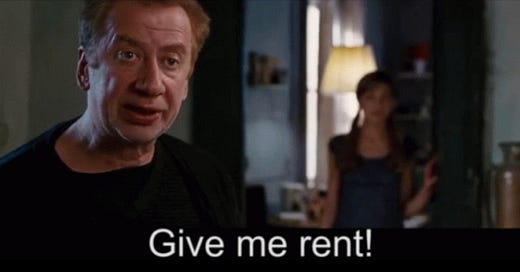



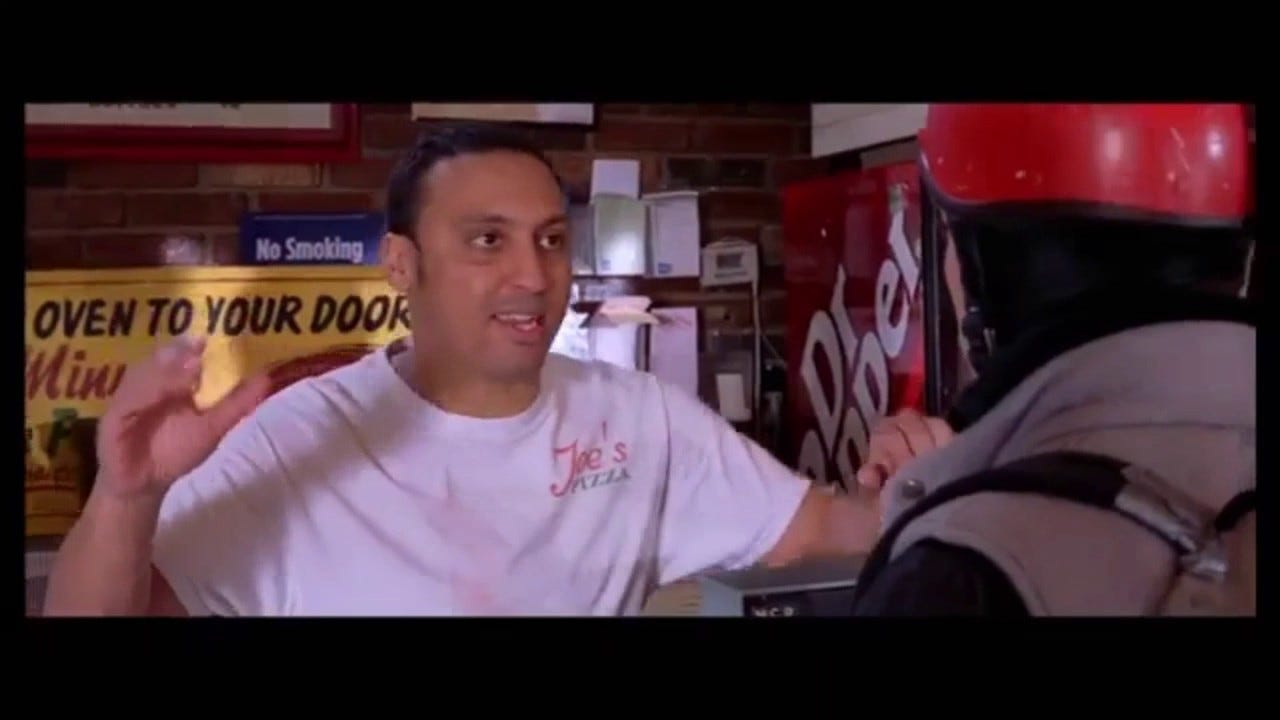
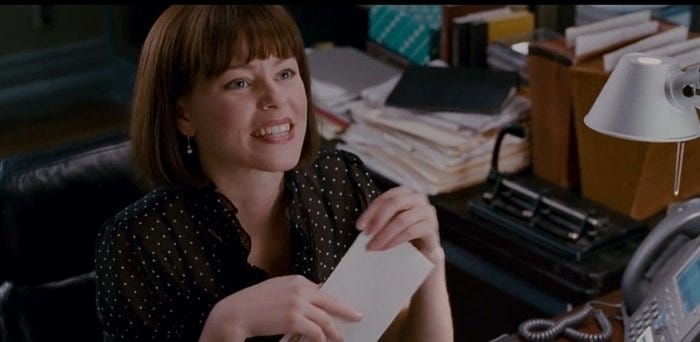
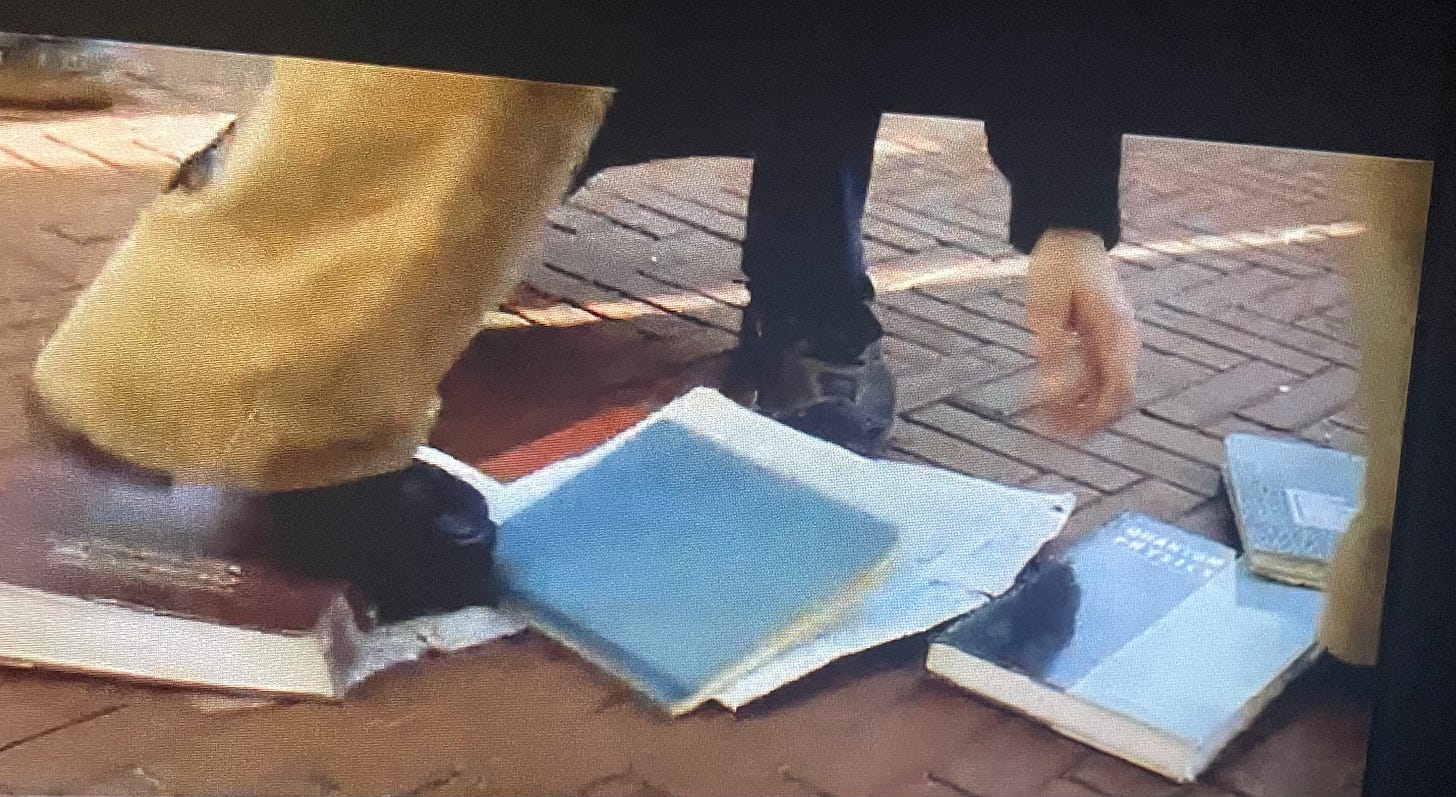
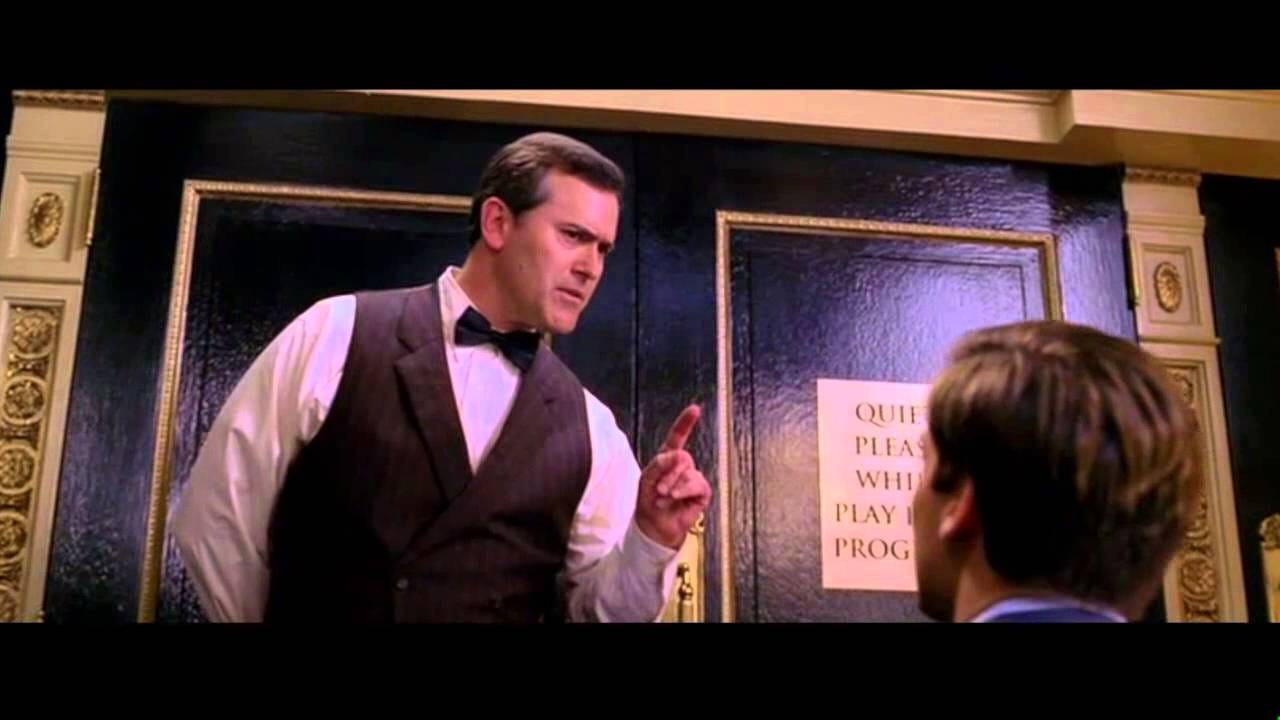

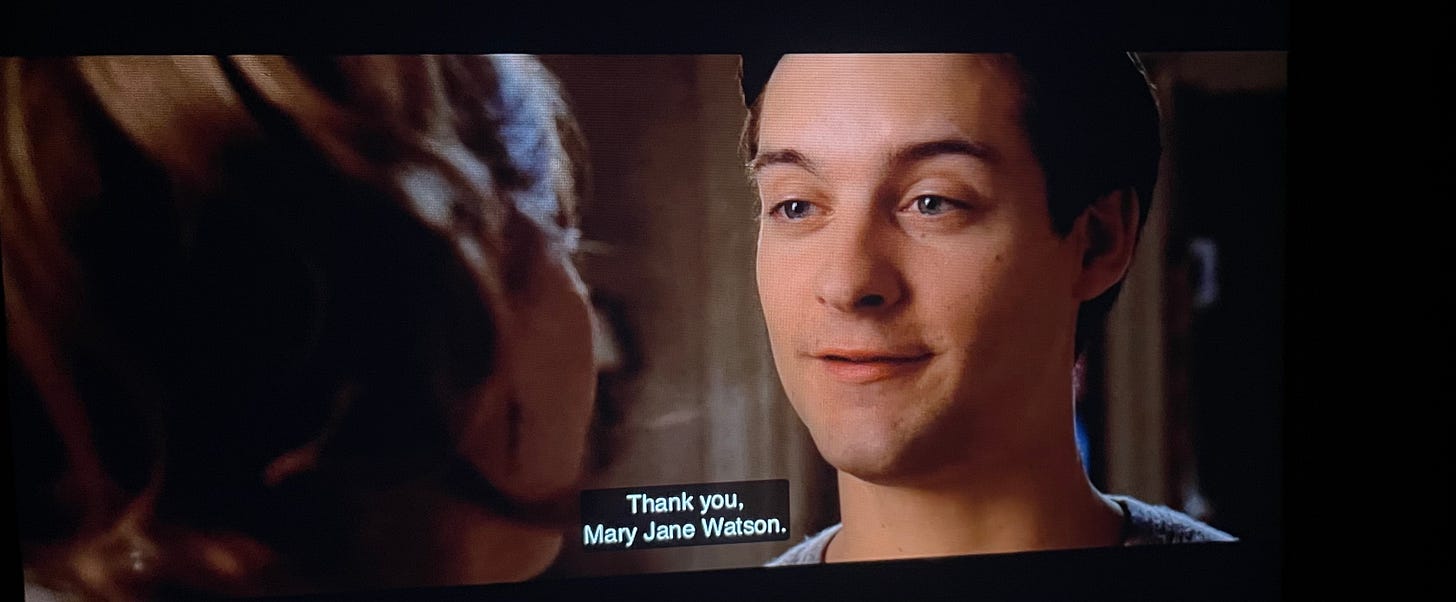
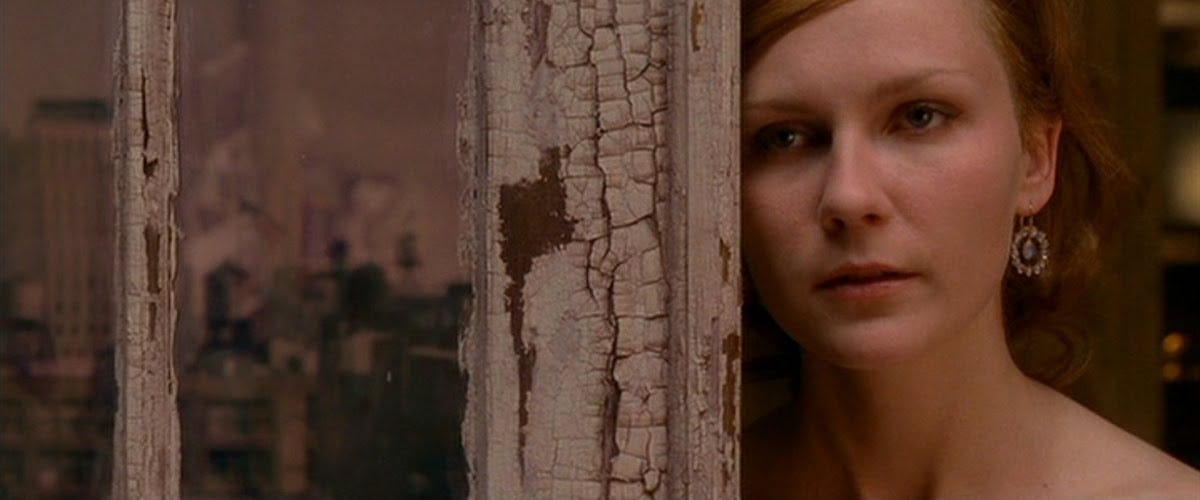
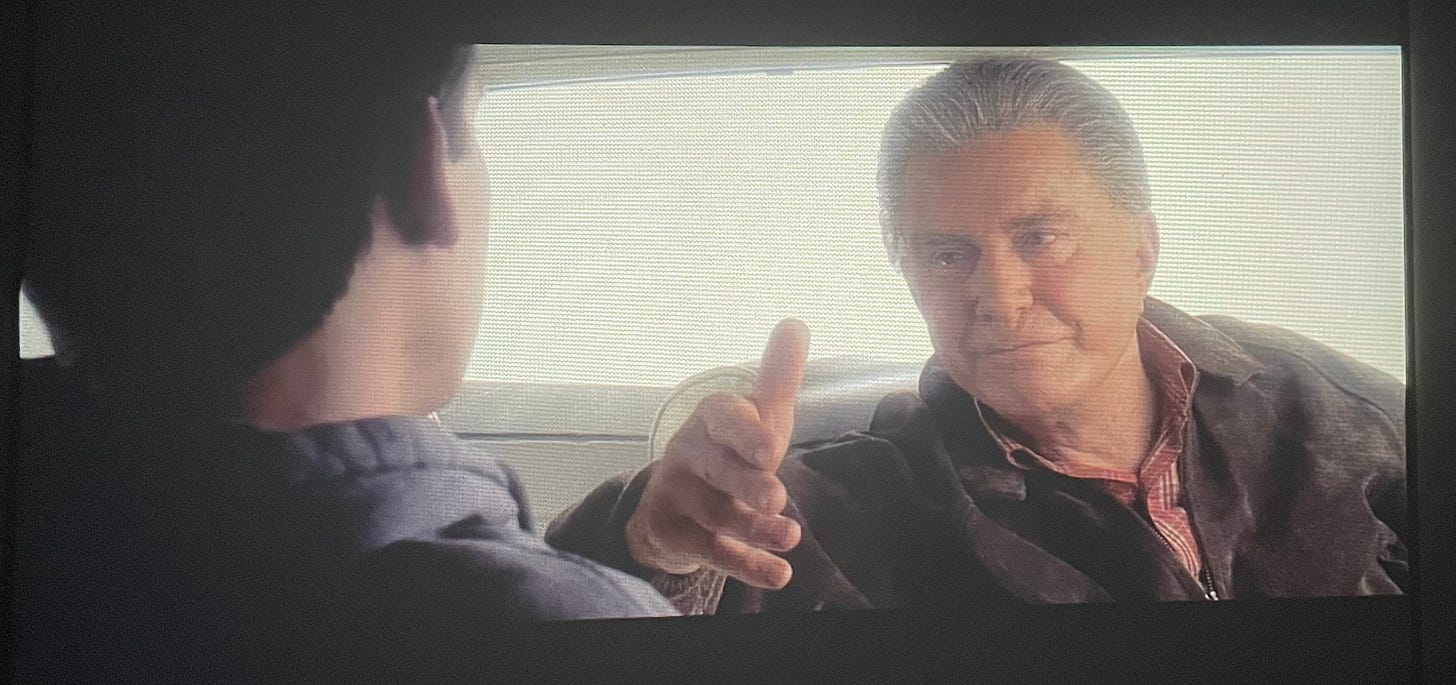




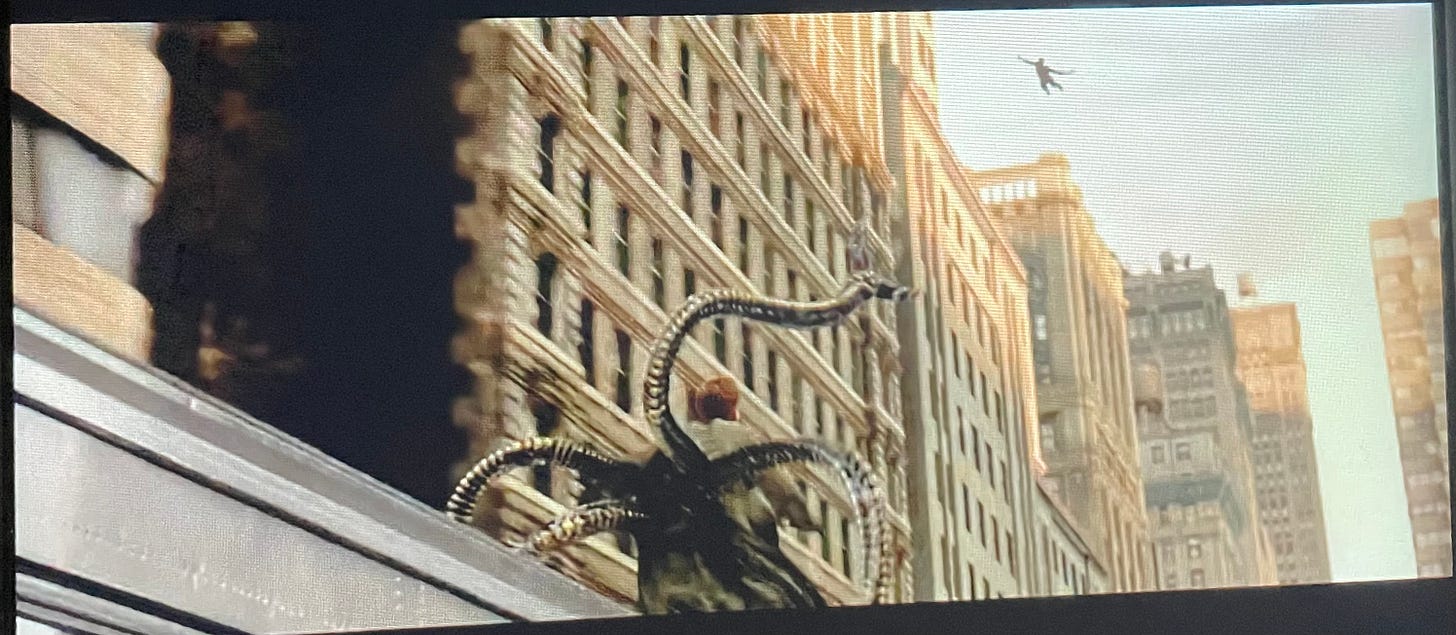
Great piece on a great movie. The grounded, personal struggles you highlight also make clear something that I've been trying to put my finger on for a little while now, which is why some quippiness is good and some quippiness is aggravating. (A lot of it is simply that some stuff isn't funny at all, but that can't be the whole story.) It's not like Marvel movies invented the action one-liner, and Spider-Man himself has always been famous for goading his antagonists. And I think the key is that sense of an earned, weary cynicism. A modern Marvel joke is often a wink at the audience, a style guide-mandate that it be clear that the main characters have also seen movies before. Spidey, at his best, is winking at himself. Does he really need to mock Bonesaw during the first movie's wrestling scene? Not really, but he clearly enjoys it. And it expresses so many things: his youthful bravado and arrogance, his wit, the resentments of a spit-upon and kicked loser in a new position of strength, perhaps a latent cruelty that's easy to indulge with power (and easy to justify, when directed at the correct target.) There's pleasure in humiliating and emasculating this asshole muscle-man, and it's cathartic and playful and troubling all at once. You learn something about who he's been, who he is, and the limitless possibilities for who he could be. It breathes life into the character, tells you something about his history and psychology, and provides some of the earliest foreshadowing of the inner turmoil you note. The cliche action quip, so often used to place characters outside of the cacophony of events, instead places Peter inside of it, suggests it's in continuity with the rest of his life, and is foundational to his tumultuous, hellish yo-yo between self-denial and self-indulgence.
Great review. I'm finally watching it all the way through for the first time today. I've only seen parts of it on TV over the years.
I don't think I'll be watching the new one anytime soon. Omikron is kicking off here now and it's only going to get worse during the holidays. Also one of my friends' dad just passed away, and we put our regular movie-going on hold.
The scene were an unconscious Octavius is about to be operated on and his robotic arms just murderize the doctors, it struck me as a very brutal and shocking scene, even though it doesn't contain any blood and gore. Love that Sam Raimi.